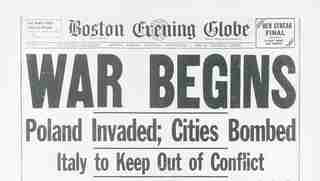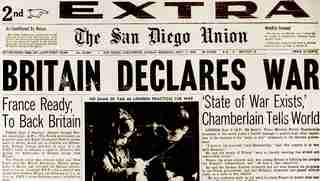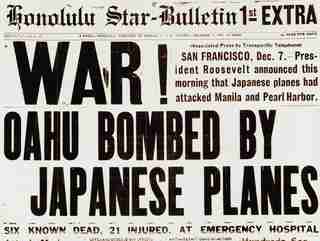War Begins

Prelude to a War
Only two decades after the end of World War I, tensions were again mounting across the globe. The Fascist dictator Adolf Hitler had risen to power in Germany and was brazenly taking over parts of Austria and Czechoslovakia—in defiance of the sanctions his country faced after losing WWI. Meanwhile, another Fascist dictator, Benito Mussolini, had ascended to power in Italy. In the Far East, Japan was in the midst of an aggressive campaign against China.
Attack on Poland
Then, on September 1, 1939, Germany launched a devastating surprise attack on Poland. Stuka (dive-bomber) squadrons assaulted Warsaw and other targets from the air, while Panzer (tank) units invaded from the ground. France and Britain declared war on Germany two days later in defense of Poland. But nothing could stop the German advance, and Poland surrendered just over two weeks after the assault began.

Europe Shattered
In 1940, Germany tore through Europe using a shocking new tactic called the Blitzkrieg, or "lightning war." German forces launched catastrophic surprise attacks combining massive air power with fast-moving ground units. The tactic worked: by mid-summer, Denmark, Norway, France, Belgium, Luxembourg and The Netherlands had surrendered.
The Battle of Britain
In July 1940, Germany focused its wrath on Britain. First, the German Luftwaffe (air force) attacked the airfields of Britain's Royal Air Force. The next month, Hitler declared a total blockade of Britain to prevent supplies from entering the country. Then, in September 1940, Hitler ordered an all-out bombing campaign against London.
The outlook for Europe darkened on September 27, 1940, when Germany, Italy and Japan signed the Tripartite Act, uniting their forces into the Axis Powers.
U.S. Neutrality and the Lend-Lease Act
The U.S. remained neutral for the first year and a half of the war. Then, on March 11, 1941, U.S. President Franklin Delano Roosevelt signed the Lend-Lease Act, authorizing U.S. ships to carry supplies across the Atlantic Ocean to Britain and other countries fighting the Axis Powers. Hitler had ordered his forces to destroy supply lines to Britain, but he expressly forbade the sinking of American ships—hoping to keep the U.S. out of the war for as long as possible.

Japan Attacks the U.S.
On December 7, 1941, Japanese planes and submarines carried out a devastating surprise assault on the U.S. Navy base in Pearl Harbor, Hawaii. The U.S. declared war on Japan the next day. On December 12, 1941, Germany and Italy declared war on the U.S. The Atlantic was no longer safe for American ships.